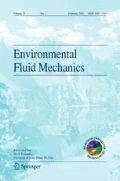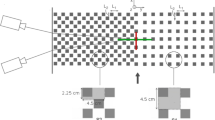Abstract
Near-bed flows in rough-bed open-channels are of relevance to river engineering, freshwater ecology and hydraulic design. Detailed measurements of near-bed flow velocity and turbulence distributions are rarely available. This paper aims to improve our understanding of near-bed flow characteristics. We performed experiments of turbulent open-channel flow over roughness elements, and made fine-scale measurements of three-dimensional velocity and turbulence quantities, using an acoustic Doppler velocimeter. The experiments allowed for the d-type, the intermediate-type and the k-type of surface roughness. The fine scale measurements covered the entire flow region in the bed vicinity, including cavities below the crests of roughness elements. Below the crests, the longitudinal velocity field displays one weak eddy in the cavity between adjacent elements for the d-type of roughness, two eddies of different strengths for the intermediate-type of roughness, and boundary-layer velocity structures for the k-type of roughness. Above the crests, the main (or longitudinal) flow velocity shows a variety of vertical structures for the three types of surface roughness. At the elevation equal to one half the roughness height above the crests, there is a lack of longitudinal variations in the main flow velocity over the length of element—cavity sequence. In other words, main-flow velocity fluctuations are small; the velocity distributions have a standard deviation equal to 5%, 6% and 7% of their mean values for the d-type, the intermediate-type, and the k-type of roughness, respectively. Practically the influence of roughness surface may be considered as capped at that elevation. The secondary flow has the highest intensity nearest the bed. Turbulence shear has the highest average value at the crest level of roughness elements.













Similar content being viewed by others
References
Amir M, Nikora VI, Stewart MT (2014) Pressure forces on sediment particles in turbulent open-channel flow: a laboratory study. J Fluid Mech 757:458–497
Blackman K, Perret L, Savory E (2015) Effect of upstream flow regime on street canyon flow mean turbulence statistics. Environ Fluid Mech 15(4):823–849
Buccolieri R, Wigö H, Sandberg M, Di Sabatino S (2017) Direct measurements of the drag force over aligned arrays of cubes exposed to boundary-layer flows. Environ Fluid Mech 17(2):373–394
Cantwell BJ (1981) Organized motion in turbulent flow. Ann Rev Fluid Mech 13(1):457–515
Chew LW, Aliabadi AA, Norford LK (2018) Flows across high aspect ratio street canyons: Reynolds number independence revisited. Environ Fluid Mech 18(5):1275–1291
Chow VT (1959) Open-channel hydraulics. McGraw-Hill, New York
Coceal O, Dobre A, Thomas TG, Belcher SE (2007) Structure of turbulent flow over regular arrays of cubical roughness. J Fluid Mech 589:375–409
Coleman SE, Nikora VI, McLean SR, Schlicke E (2007) Spatially averaged turbulent flow over square ribs. J Eng Mech 133(2):194–204
Davis JA, Barmuta LA (1989) An ecologically useful classification of mean and near-bed flows in streams and rivers. Freshw Biol 21(2):271–282
De Bruin HAR, Moore CJ (1985) Zero-plane displacement and roughness length for tall vegetation, derived from a simple mass conservation hypothesis. Bound Layer Meteorol 31(1):39–49
Florens E, Eiff O, Moulin F (2013) Defining the roughness sublayer and its turbulence statistics. Exp Fluids 54(4):1500
Henderson FM (1966) Open channel flow. Prentice-Hall, Upper Saddle River
Hertwig D, Soulhac L, Fuka V, Auerswald T, Carpentieri M, Hayden P, Robins A, Xie ZT, Coceal O (2018) Evaluation of fast atmospheric dispersion models in a regular street network. Environ Fluid Mech 18(4):1007–1044
Hong J, Katz J, Schultz MP (2011) Near-wall turbulence statistics and flow structures over three-dimensional roughness in a turbulent channel flow. J Fluid Mech 667:1–37
Jesson MA, Bridgeman J, Sterling M (2015) Novel software developments for the automated post-processing of high volumes of velocity time-series. Adv Eng Softw 89:36–42
Kirkgöz MS (1989) Turbulent velocity profiles for smooth and rough open channel flow. J Hydraul Eng 115(11):1543–1561
Kironoto BA, Graf WH (1995) Turbulence characteristics in rough non-uniform open-channel flow. Proc Inst Civ Eng Water Marit Energy 112(4):336–348
Lee JH, Seena A, Lee SH, Sung HJ (2012) Turbulent boundary layers over rod-and cube-roughened walls. J Turbul 13(1):N40
Leonardi S, Orlandi P, Antonia RA (2007) Properties of d-and k-type roughness in a turbulent channel flow. Phys Fluids 19(12):125101
Manes C, Pokrajac D, McEwan I (2007) Double-averaged open-channel flows with small relative submergence. J Hydraul Eng 133(8):896–904
Mazzuoli M, Uhlmann M (2017) Direct numerical simulation of open-channel flow over a fully rough wall at moderate relative submergence. J Fluid Mech 824:722–765
Mignot E, Barthélemy E, Hurther D (2009) Double-averaging analysis and local flow characterization of near-bed turbulence in gravel-bed channel flows. J Fluid Mech 618:279–303
Munson BR, Young DF, Okiishi TH, Huebsch WW (2006) Fundamentals of fluid mechanics, vol 69. Wiley, Hoboken, p 520
Nikora N, Nikora V, O’Donoghue T (2013) Velocity profiles in vegetated open-channel flows: combined effects of multiple mechanisms. J Hydraul Eng 139(10):1021–1032
Nikora V, Goring D, McEwan I, Griffiths G (2001) Spatially averaged open-channel flow over rough bed. J Hydraul Eng 127(2):123–133
Nikora V, Koll K, McEwan I, McLean S, Dittrich A (2004) Velocity distribution in the roughness layer of rough-bed flows. J Hydraul Eng 130(10):1036–1042
Panton RL (2001) Overview of the self-sustaining mechanisms of wall turbulence. Prog Aerosp Sci 37(4):341–383
Perry AE, Schofield WH, Joubert PN (1969) Rough wall turbulent boundary layers. Journal of Fluid Mechanics 37(2):383–413
Pokrajac D, Finnigan JJ, Manes C, McEwan I, Nikora V (2006) On the definition of the shear velocity in rough bed open channel flows. River Flow 1:89–98
Raudkivi AJ (1998) Loose boundary hydraulics. CRC Press, Boca Raton
Robinson SK (1991) Coherent motions in the turbulent boundary layer. Ann Rev Fluid Mech 23(1):601–639
Rouse H (1938) Fluid mechanics for hydraulic engineers. McGraw-Hill Book Company, inc., New York
Rouzes M, Moulin FY, Florens E, Eiff O (2019) Low relative-submergence effects in a rough-bed open-channel flow. J Hydraul Res 57(2):139–166
Sarkar S, Dey S (2010) Double-averaging turbulence characteristics in flows over a gravel bed. J Hydraul Res 48(6):801–809
Shim G, Prasad D, Elkins CJ, Eaton JK, Benson MJ (2019) 3D MRI measurements of the effects of wind direction on flow characteristics and contaminant dispersion in a model urban canopy. Environ Fluid Mech 19(4):851–878
Singh SK, Debnath K, Mazumder BS (2017) Turbulence over cube-mounted rough bed using spatiotemporal averaging approach. Can J Civ Eng 44(7):504–517
Tachie MF, Adane KK (2007) Piv study of shallow open channel flow over d-and k-type transverse ribs. J Fluids Eng 129(8):1058–1072
Tennekes H, Lumley JL (1972) A first course in turbulence. MIT Press, Cambridge
Wang XK, Ye C, Wang BJ, Yan XF (2015) Experimental study on velocity profiles with different roughness elements in a flume. Acta Geophys 63(6):1685–1705
Wilcox DC (2006) Turbulence modeling for CFD, 3rd Edition. DCW Industries, La Canada
Yee E, Gailis RM, Hill A, Hilderman T, Kiel D (2006) Comparison of wind-tunnel and water-channel simulations of plume dispersion through a large array of obstacles with a scaled field experiment. Bound Layer Meteorol 121(3):389–432
Çengel YA, Cimbala JM (2006) Fluid mechanics fundamentals and applications. McGraw Hill Publication, New York, p 185201 (International Edition)
Zajic D, Fernando HJ, Brown MJ, Pardyjak ER (2015) On flows in simulated urban canopies. Environ Fluid Mech 15(2):275–303
Acknowledgements
This study received financial support from the Natural Sciences and Engineering Research Council of Canada through the Discovery Grant held by S. Li.
Author information
Authors and Affiliations
Corresponding author
Additional information
Publisher's Note
Springer Nature remains neutral with regard to jurisdictional claims in published maps and institutional affiliations.
Rights and permissions
About this article
Cite this article
Li, J., Li, S.S. Near-bed velocity and shear stress of open-channel flow over surface roughness. Environ Fluid Mech 20, 293–320 (2020). https://doi.org/10.1007/s10652-019-09728-3
Received:
Accepted:
Published:
Issue Date:
DOI: https://doi.org/10.1007/s10652-019-09728-3




